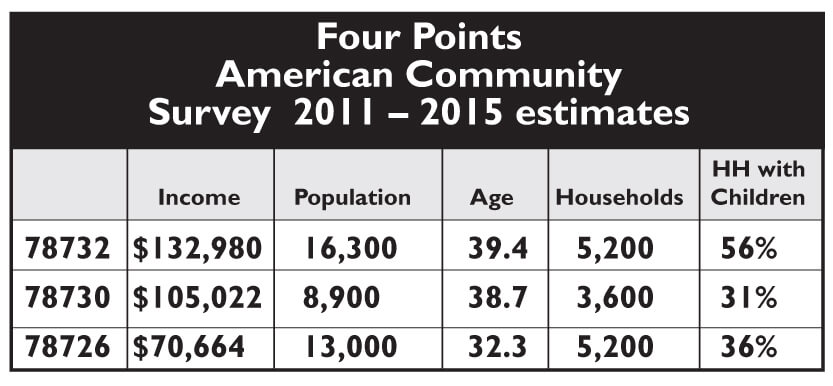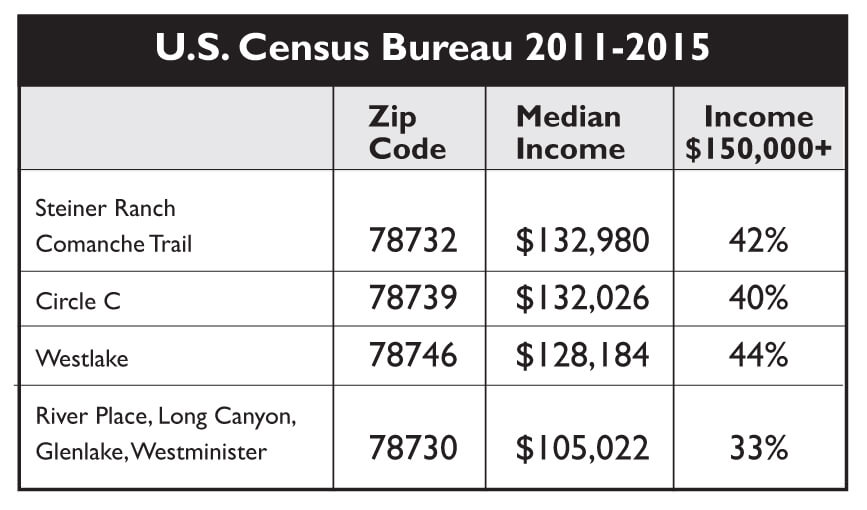
The chart uses U.S. Census Bureau data and shows median income and median age as well as percentage of households with children.
Census data shows 5-year estimates
By CASSIE MCKEE
Four Points News
The 78732 zip code, which includes Steiner Ranch, continues to have the highest median household income in Austin, according to updated U.S. Census Bureau data from the 2011 – 2015 American Community Survey five-year estimates.
From 2011-2015, the median income of households in 78732 was $132,980. An estimated 42 percent of households had income of $150,000 or more.
William Mellor, vice president of Angelou Economics, said while his firm has not done an analysis on individual zip codes in the city, there has been a trend of significant growth in west Austin.
“That area of the city has been growing significantly over the last couple of years,” Mellor said. “In terms of trends, we notice a lot of CEOs living in that area of town, so it’s not surprising to see the incomes growing so much.”

The chart uses U.S. Census Bureau data and shows median income and income $150,000 or greater for several Austin zip codes during the five years between 2011 and 2015.
Mellor said people are drawn to west Austin because of the quality of life it offers.
“The housing product is of a higher value,” he said. “You tend to have more land, bigger houses and beautiful scenery. The issues of congestion are not as bad once you get out of the core city.”
Another western zip code, the 78739 zip code, which includes Circle C in southwest Austin, came in just behind with a median household income of $132,026. An estimated 40 percent of households in that zip code had income of $150,000 or more.
Westlake’s 78746 zip code had a median household income of $128,184 during the same five-year period. An estimated 44 percent had income over $150,000 or more.
In the 78730 zip code, which includes River Place, Long Canyon, Westminster Glen and Glenlake, the median income was $105,022 during the same five year period. An estimated 33 percent had income of $150,000 or more.
Four Points is also made up of a portion of 78726. The median income of households in 78726 was $70,664. An estimated 27 percent had income of $150,000 or more.
Education
The data also shows that the Four Points area has a very high percentage of residents with a college degree. In 78732, 74 percent of residents had a bachelor’s degree or higher. In 78730, 72 percent had at least a bachelor’s degree, and in 78726, 63 percent had at least a bachelor’s degree.
Mellor said he wasn’t surprised by the high percentages.
“Because of the number of CEOs and executives living out there, you’re going to see much higher levels of education,” he said.
By comparison, in the 78757 zip code, which includes the North Shoal Creek neighborhood in central Austin, only 56 percent had a bachelor’s degree or higher.
Students
Among the three Four Points zip codes, 78732 had the most students, with 5,600 young people enrolled in school between 2011 and 2015. Nursery school and kindergarten enrollment was 934, elementary through high school enrollment was 4,300, and college or graduate school enrollment was 438.
In 78730, 2,400 young people were enrolled in school. Nursery school and kindergarten enrollment was 287, elementary or high school enrollment was 1,600, and college or graduate school enrollment was 541.
The total school enrollment in 78726 was 3,900. Nursery school and kindergarten enrollment was 418, elementary or high school enrollment was 2,300, and college or graduate school enrollment was 1,200.
Housing costs
Property values continue to rise in Austin and in 78732, the median monthly housing costs for mortgaged owners was $3,226, while non-mortgaged owners paid $1,280, and renters paid $1,393.
In 78730, the median monthly housing costs for mortgaged owners was $3,247, while non-mortgaged owners paid $1,257, and renters paid $1,187.
In 78726, the median monthly housing costs for mortgaged owners was $2,355, while non-mortgaged owners paid $1,053, and renters paid $1,059.
Mellor said one of the primary challenges Austin is currently facing is the issue of affordability.
“The growth over the past few years has been significant, which has led to Austin’s share of challenges, among those is affordability,” he said. “There’s a real concern that a lot of people are being priced out of the market. If you’re looking to purchase a home, it can make things pretty difficult.”
He said there are not enough homes being built to meet the demand.
“The growth of the city has outpaced the ability of private developers to put homes on the market,” Mellor said.
